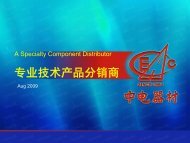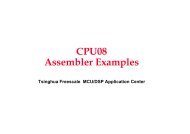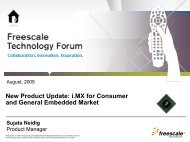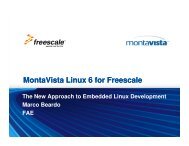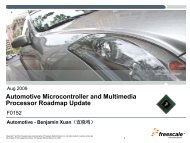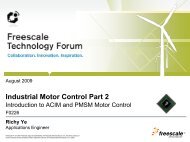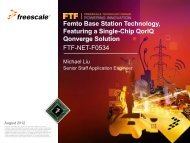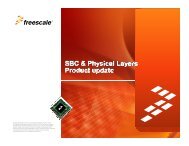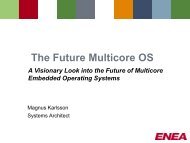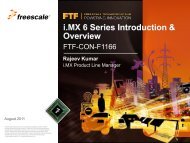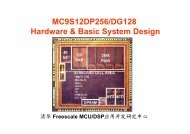Request
Request
Request
Create successful ePaper yourself
Turn your PDF publications into a flip-book with our unique Google optimized e-Paper software.
• PCI Express is a complicated high-speed serial data transmission protocol<br />
with 3 layers defined: Transaction Layer, Data Link Layer, and Physical<br />
Layer.<br />
• A good understanding of the PCI and PCIe specification will speed up the<br />
debug process.<br />
• With roughly 150 registers in each controller, it’s important to learn which<br />
register means what and know which register to look after when an error<br />
occurs.<br />
• Plan ahead with PBL Image Tool to pick the desired SerDes lane<br />
assignment, schematics review, correct reference clock frequency,<br />
connection scheme and programming model. This will smooth the<br />
development effort.<br />
• Implement at least a mid-bus probe footprint on board if possible. It really<br />
pays off in the future debug!<br />
• When experiencing error, fully utilize our register dump to aid the debug. It’s<br />
critical to have PCIe protocol analyzer trace if register dump doesn’t help!<br />
TM<br />
57<br />
Freescale, the Freescale logo, AltiVec, C-5, CodeTEST, CodeWarrior, ColdFire, ColdFire+, C-Ware, the Energy Efficient Solutions logo, Kinetis,<br />
mobileGT, PowerQUICC, Processor Expert, QorIQ, Qorivva, StarCore, Symphony and VortiQa are trademarks of Freescale Semiconductor, Inc.,<br />
Reg. U.S. Pat. & Tm. Off. Airfast, BeeKit, BeeStack, CoreNet, Flexis, MagniV, MXC, Platform in a Package, QorIQ Qonverge, QUICC Engine,<br />
Ready Play, SafeAssure, the SafeAssure logo, SMARTMOS, TurboLink, Vybrid and Xtrinsic are trademarks of Freescale Semiconductor, Inc. All<br />
other product or service names are the property of their respective owners. © 2012 Freescale Semiconductor, Inc.



